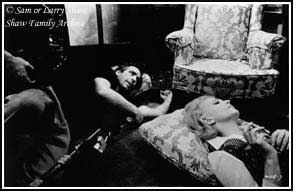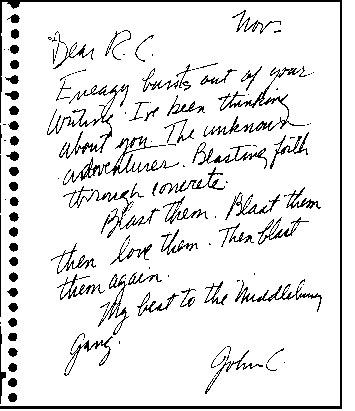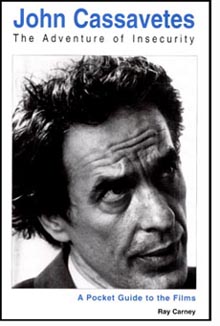|
 There
are films with vivid characters, gripping plots, and memorable lines.
And then there are films like A Woman Under the Influence—films
that reach into your heart and sear it with pain and joy. Cassavetes gives
us experiences as complex, demanding, and intense as life itself—at least
in part because we encounter them in the same unanalyzed, uneditorialized,
unabstracted way we encounter things in our own lives. There
are films with vivid characters, gripping plots, and memorable lines.
And then there are films like A Woman Under the Influence—films
that reach into your heart and sear it with pain and joy. Cassavetes gives
us experiences as complex, demanding, and intense as life itself—at least
in part because we encounter them in the same unanalyzed, uneditorialized,
unabstracted way we encounter things in our own lives.
As the filmmaker noted in an interview, most
films depend on a shorthand that allows us to view them in a fundamentally
different way from the way we experience things outside of the movies.
They employ a kind of code: See this. Think that. Get it? Got it. They
tell us what to know and feel, what things mean. They make points. The
result is a slight but decisive abstraction from everything in them. The
viewer is always at a certain critical distance from what is on screen.
These movies are about an experience, rather than giving us the
experience itself. Rather than plunging us headlong into life,
these movies tell us about life—the way reading an essay about
an experience is entirely different from having the experience.
 Cassavetes takes away the aboutness, the
abstraction. To watch one of his movies is not to learn about a
group of characters and situations, but to have something very close to
the kind of experiences we would have if we were actually in similar situations
with similar figures. Cassavetes takes away the aboutness, the
abstraction. To watch one of his movies is not to learn about a
group of characters and situations, but to have something very close to
the kind of experiences we would have if we were actually in similar situations
with similar figures.
The secret of Cassavetes’ method is to deny
viewers every form of intellectual distance and control. The experiences
he presents can’t be held intellectually at arm’s length. They won’t be
simplified by being translated into received ideas or emotions. They resist
being formulated. They must be challengingly negotiated moment by moment
the way we live and feel things in real life. In all of their unresolved
sprawl and mutability, the experiences in his films are the opposite of
the canned, pre–programmed summaries of experience most other movies provide.
Real
emotional experiences are never formulatable the way the synthetic emotions
most other films provide are. In fact, if you can even say what emotion
you are feeling while you are having it—as you almost always can in most
other movies—it is proof that you are actually at a remove from it. If
you can think about it, analyze it, understand it, it doesn’t have the
power of feelings in life. That is the state of intensity—or reality—that
Cassavetes brings back to the cinematic experience. He moves us beyond
thought.
There are many ways Cassavetes could have
turned A Woman Under the Influence into the other kind of movie
by simplifying it. While other films provide experiences that are clear,
Cassavetes gives them to us murky. Events and emotions are not cut into
bite–sized bits for easy consumption. They are presented "undigested"—in
all of their mixed–up glory—the same way they are encountered in life.
Viewers are left at least a little in the dark. They are at sea, somewhat
uncertain a lot of the time about what they are supposed to think and
feel. The mystery isn’t explained out of life.
 Even if the viewer does succeed in figuring
out a character or scene, it is sure to change. Characters’ behavior is
wildly unpredictable and mutable. We have to scramble to understand what
is going on, racing to keep up with continuously changing tones. Feelings
keep shifting (as in the spaghetti breakfast scene, which cycles through
five or six or more entirely different moods before it is over). We can’t
slip into a simple mood and cruise along on emotional autopilot. We are
forced to stay emotionally on the qui vive—to keep responding,
shot–by–shot, second–by–second. In its open–endednes, it is a simultaneously
exhilarating and terrifying vision of life. (Cassavetes told me that he
thought comedy was a deeper and more important dramatic form than serious
drama, because "you could put more different feelings into a scene,
more views of one thing"—a pretty good description of all of his
work—comic or otherwise. Chekhov would have agreed.) Even if the viewer does succeed in figuring
out a character or scene, it is sure to change. Characters’ behavior is
wildly unpredictable and mutable. We have to scramble to understand what
is going on, racing to keep up with continuously changing tones. Feelings
keep shifting (as in the spaghetti breakfast scene, which cycles through
five or six or more entirely different moods before it is over). We can’t
slip into a simple mood and cruise along on emotional autopilot. We are
forced to stay emotionally on the qui vive—to keep responding,
shot–by–shot, second–by–second. In its open–endednes, it is a simultaneously
exhilarating and terrifying vision of life. (Cassavetes told me that he
thought comedy was a deeper and more important dramatic form than serious
drama, because "you could put more different feelings into a scene,
more views of one thing"—a pretty good description of all of his
work—comic or otherwise. Chekhov would have agreed.)
A Woman Under the Influence creates
a different kind of viewer from the mainstream movie. Because feelings
are changing so rapidly, our relationship to the experience must be far
quicker, more intuitive, less theoretical, less abstract. Because things
are shifting around on us so fluidly, we are prevented from assuming an
intellectual stance or maintaining a purely conceptual relation to them.
That would be too static. Ideas are too slow to keep up with changes of
this rapidity; only emotions will do. We cannot unify the shifting details
into a generalization. Since it is changing so rapidly, we cannot fly
50,000 feet above the experience to take it in as an abstraction. We must
surf on an wave of ever–shifting perceptual experience. We cannot relax
our state of attentiveness for a second.
This page only
contains excerpts and selected passages from Ray Carney's John Cassavetes:
The Adventure of Insecurity. To learn how to obtain the book, please
click
here.
|









